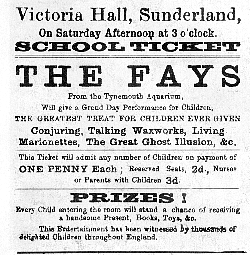Top Qs
Timeline
Chat
Perspective
Victoria Hall disaster
Crowd crush that occurred in Sunderland, England in 1883 From Wikipedia, the free encyclopedia
Remove ads
The Victoria Hall disaster occurred on 16 June 1883 at the Victoria Hall in Sunderland, England, when the distribution of free toys caused a crowd crush resulting in 183 children (aged between 3 and 14 years old) to be crushed to death due to compressive asphyxia.
Remove ads
Events
Summarize
Perspective

On 16 June 1883, a children's variety show was presented by travelling entertainers Mr. and Mrs. Fay.[1][2] The travelling magic show, consisting of a variety of conjuring tricks and illusions, passed without incident, except when a puff of smoke from one of the tricks "disagreed" with some of those in the front row, and caused a few children to be sick.[citation needed]
At the show's end, an announcement was made that children with certain numbered tickets would be presented with a prize upon exit. At the same time, entertainers began distributing gifts from the stage to the children in the stalls. Worried about missing out on the treats, many of the estimated 1,100 children in the gallery surged toward the staircase leading downstairs.[3]
At the bottom of the staircase, the door opened inward and had been bolted to leave a gap only wide enough for one child to pass at a time. It is believed this was to ensure the orderly checking of tickets.[4] With few accompanying adults to maintain order, the children surged down the stairs toward the door. Those at the front became trapped and were crushed to death by the weight of the crowd behind them.[2]
When the adults in the auditorium realised what was happening, they rushed to the door but could not open it as the bolt was on the children's side. Caretaker Frederick Graham tried in vain to disentangle the pile-up, then ran up another staircase and diverted approximately 600 children to safety by another exit.[1] Meanwhile, other adults pulled the children one by one through the narrow gap, before one man wrenched the door off its hinges.[1]
In his 1894 account, survivor William Codling, Jr., described the crush and the realisation that people were dying:
Soon we were most uncomfortably packed but still going down. Suddenly I felt that I was treading upon someone lying on the stairs and I cried in horror to those behind "Keep back, keep back! There's someone down." It was no use, I passed slowly over and onwards with the mass and before long I passed over others without emotion.[5]
Remove ads
Aftermath
Summarize
Perspective

The compressive asphyxia as a result of the crowd crush killed 183 children between 3 and 14 years of age. Medical findings of these children were described in detail in the British Medical Journal of June 23, 1883.[6]
Queen Victoria sent a message of condolence to the grieving families and contributed to the disaster fund.[7] Donations sent from all over Britain totalled £5,000 (equivalent to £636,096 in 2023[8]) and were used for the children's funerals and a memorial in Mowbray Park. The memorial of a grieving mother holding a dead child was later moved to Bishopwearmouth Cemetery, where it gradually fell into disrepair and was vandalised. In 2002, the marble statue was restored for £63,000 and moved back to Mowbray Park with a protective canopy.[2][9]
Newspaper reports at the time triggered a mood of national outrage. The resulting inquiry led to legislation that public entertainment venues be fitted with a minimum number of outward opening emergency exits,[2] which led to the invention of "push bar" emergency doors.[10] This law still remains in force.[2] No one was prosecuted for the disaster[2] and the person responsible for bolting the door was never identified. The Victoria Hall remained in use until 1941 when it was destroyed by a World War II parachute bomb.[2][11]
Annual memorial services were set up in 2010 by the Sunderland Old Township Heritage Society.[12]
Remove ads
Depiction in media
The disaster inspired a poem by Scottish poet William McGonagall entitled "The Sunderland Calamity".[13]
See also
References
Wikiwand - on
Seamless Wikipedia browsing. On steroids.
Remove ads


